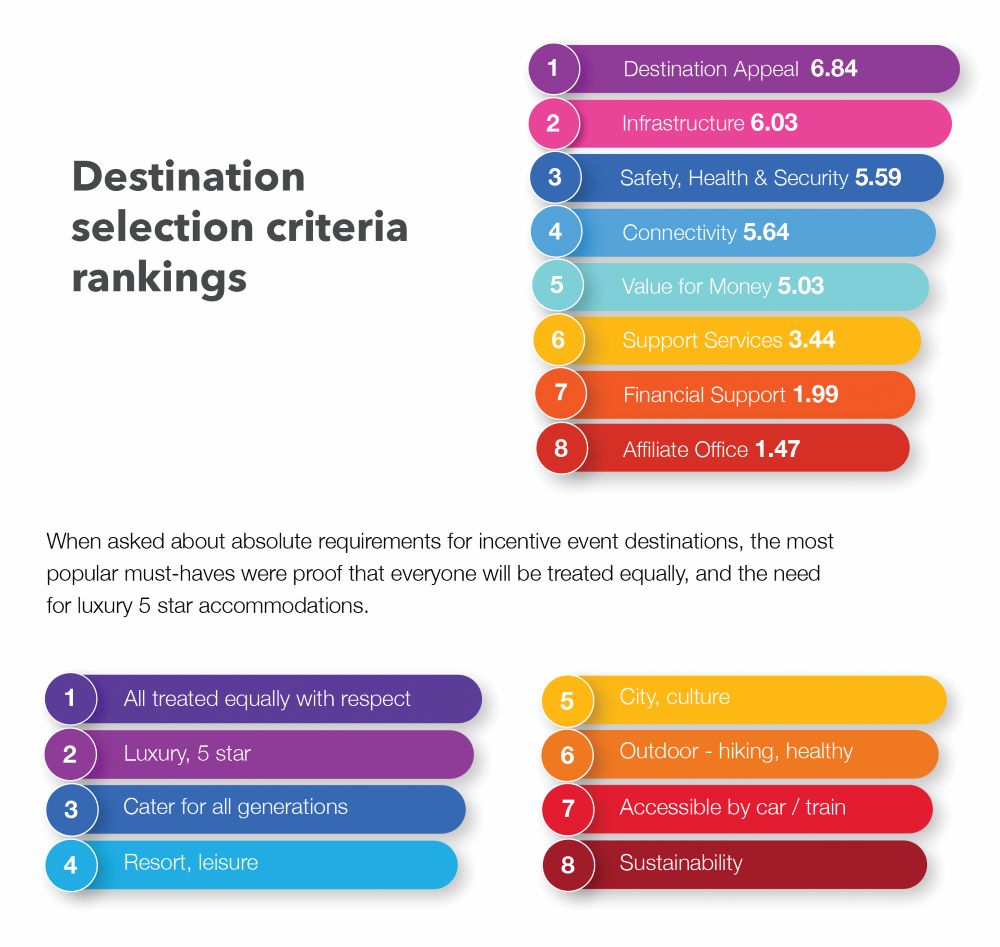The incentive travel segment has undergone a fairly radical transformation starting with the pandemic, when travel restrictions and outright shutdowns—especially to international destinations—caused a whole industry to reexamine itself or simply survive.
Emerging from the pandemic era, however, the incentive travel segment is reverting to form, but with some major shifts related to key-stakeholder involvement and the preferences of a new generation of qualifiers.
The July Incentive Travel & Motivational Events Study, issued by SITE and sponsored by Hilton, revealed some interesting findings about the shifting sands of incentive travel programs.
[Related: How a Tech-Savvy Generation Is Changing Incentive Travel Programs]

“I think one of the interesting things that emerged from the report was basic—the path to influence,” said Padraic Gilligan, chief marketing officer for SITE. “I think we traditionally believed that incentive travel lived under sales in so far as the incentive travel reward was what was given to the salesperson when he or she reached quota. The reporting structure is actually much, much more nuanced than that. Some are reporting to sales, but only 13%. A bigger number are reporting to marketing.
“But most interesting was that about 24% of those organizing incentive travel programs in corporations are actually reporting directly to the CEO,” he added. “It obviously illustrates the importance given by CEOs to the incentive program and the need that they feel to be vested in it on the basis that ultimately it connects in with corporate culture, and the CEO is the guardian of the corporate culture.”
Gilligan said the survey, which included responses from nearly 100 global event professionals, found that destination appeal is still the driving factor in incentive programs, with infrastructure coming in at No. 2 and safety, health and security No. 3.
[Related: Explore The Shifting Trends in Incentive Travel Destination Selection]
“Another thing that emerged very, very strongly in terms of types of destinations was a destination where all participants will be treated equally with respect, and that was the No. 1,” Gilligan said, adding that selecting destinations where participants are treated equally, such as LGBTQ+ attendees, was a top concern with organizations planning incentive travel programs.

The preferences of emerging demographics in the business world, such as Gen Z qualifiers and incentive organizers, is key in the shift.
“You need to onboard not only your DMOS, but your hotels, your DMCs. Everybody, really, has to redefine what we offer to make sure that we capture the attention and the desire of those new generations that don’t have the same way of seeing life and their future as other generations,” said Benoit Sauvage, chair of the SITE Research & Content Committee as well as founder and CEO of Connect DMC.
Sauvage listed five key trends:
- Generational shift: There is a need to change the rules of the game to make sure Gen Z qualifies for trips, aside from traditional metrics such as the achievement of sales goals.
- AI: While nothing can replace the key attributes of a destination—AI hasn’t yet adequately recreated the swaying palm trees and ocean breezes of a Caribbean beach, for example—artificial intelligence is starting to reinvent business systems to create, organize and execute incentives.
- ESGs: People, the planet and profit are still top concerns, such as carbon-neutral events (especially in Europe), along with DEIB initiatves and considerations.
- Well-being: Well-being, especially the mental well-being of both attendees and incentive planners, has become a higher priority, with CSR programs becoming more prominent.
- Corporate culture: Everything comes down to corporate culture from every level. Incentive travel planners need to adapt their services to each company according to their corporate culture.

Gilligan added that there also appears to be a transformational shift in the core purpose of incentive travel programs.
“We’ve seen that there’s a definite shift from incentives that generate hard dollars to incentives that create soft power,” Gilligan offered. “Increasingly, what we’re seeing is the soft power that naturally takes place when corporations and qualifiers [interact] in an environment outside of the office; those kinds of memories and moments that are gifted to people are the ones that sustain them…because they had a conversation with a high-ranking corporate officer or played golf with the CEO.
“That’s why CEOs are invested in it and want to be part of the experience themselves, and part of the decision-making process,” he added, “because they know their best people and customers will be at that event and they want to be there with them.”
[Related: Dear Ashley: 7 Ways to Immerse Attendees in Local Culture Pre-Arrival]
Insights From BCD
Global incentive travel company BCD Meetings & Events is seeing some of the same trends reflected in the SITE report.

“The trend is less around destinations and more about demographic shifts in being more open minded about destinations,” said Melissa Moten, VP of experience and event solutions for BCD. “The old school was to take a North American group to Mexico, then the Caribbean and then to [English-language-friendly] countries in Europe. Now we have 20-year-olds to 50-year-olds attending these events, which is great, but they really want different things.”
Moten said BCD has a handful of customers that conduct multi-wave incentives, including 24 programs that were conducted over the course of three weeks.
Moten echoed the results of the SITE study in regards to the increasing involvement of CEOs in the incentive travel decision-making process, which also points to the need to inspire potential qualifiers and create corporate culture buy-in.
“I think the CEO is taking a stronger role in the process,” she said. “Ten years ago you would send a proposal to the meeting planner, they would put together an analysis grid very much focused on price. But I think we have a younger C-suite in these industries, so that’s driving the change.
“The incentives that we get really strong attendee feedback from are the ones in which the leadership team is very proactive in the messaging and building a very strong employee campaign that is not rushed,” she continued. “More organizations are back into a three- to five-year planning schedule so they can be more intentional in planning the event.”

As in any incentive travel era, creativity is still king when it comes to the top programs.
“The other thing we’re seeing is to not be afraid of reinventing your agenda,” Moten said. “Budgets aren’t increasing but attendees are. We’re really pushing our clients to be open minded and shake it up a bit.”
Read more: Meetings Today Incentive Travel Content







